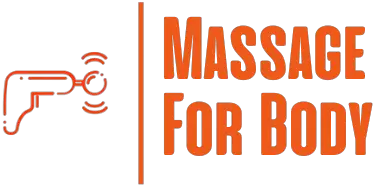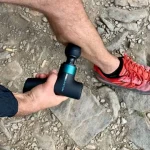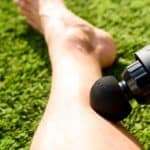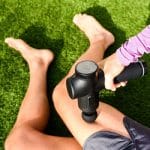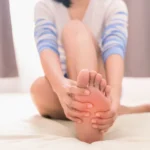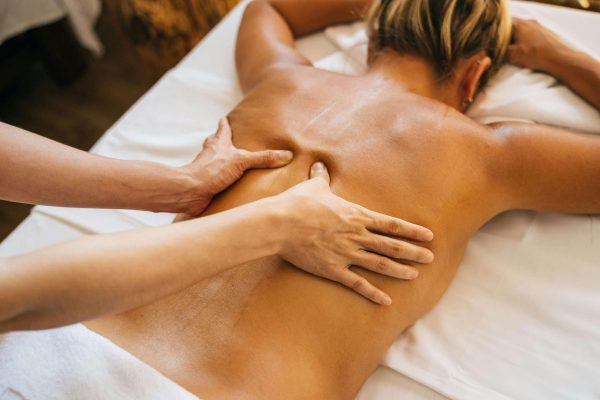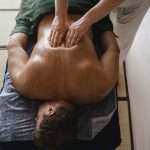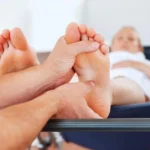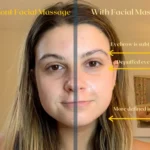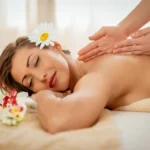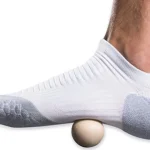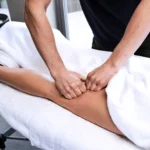Feeling sore or tender after a shot and thinking about giving it a quick rub? You’re not alone. Many people instinctively try to ease injection-site pain with a gentle massage — but according to current medical guidance, that’s not always a good idea.
Healthcare organizations such as the CDC and Cleveland Clinic advise against massaging, rubbing, or applying pressure to most injection sites, as doing so can increase irritation, worsen inflammation, and even affect how the medication or vaccine is absorbed.
In this article, we’ll break down what the research and expert recommendations say about injection-site massage. You’ll learn:
- When massage might help — and when it may actually cause harm
- What medical professionals recommend after common injections and vaccines
- Safer, evidence-supported alternatives to relieve post-injection discomfort
Before you reach for your arm or thigh, here’s what experts say you should know.
⚠️ Medical Safety Disclaimer:
The information in this article is for general educational purposes only and is not a substitute for medical advice, diagnosis, or treatment.
Injection sites can be medically sensitive areas, and reactions vary from person to person. Never massage, press, or manipulate an injection site unless specifically instructed by a qualified healthcare professional.
Seek urgent medical care if you experience:
- increasing redness, swelling, or warmth
- severe pain at or around the injection site
- fever, chills, or flu-like symptoms
- signs of infection (pus, streaking, spreading rash)
- dizziness, difficulty breathing, or allergic reactions
For personalised guidance, always follow the instructions provided by your doctor, pharmacist, or vaccination nurse. If you have concerns after any injection, call your healthcare provider, local medical helpline, or visit your nearest urgent care clinic.
Table of Contents
Reasons Not to Massage After an Injection

⚠️ Why You Shouldn’t Massage an Injection Site After a Vaccine
Massaging an injection site might seem like a quick way to relieve pain or help a vaccine “settle in,” but doing so can actually cause more harm than good. Here’s why experts typically advise against it:
❌ It May Disrupt the Vaccine
Vaccines are usually delivered into the muscle to be absorbed gradually by the immune system. Massaging the injection site can cause the vaccine to disperse too quickly or move into surrounding tissues, reducing its effectiveness and potentially increasing side effects.
❌ It Can Irritate the Area
The tissue around an injection site is already inflamed from the needle and the injected substance. Rubbing or massaging can worsen this irritation, leading to increased redness, swelling, and discomfort—especially with vaccines known to cause local reactions. This increased pressure can irritate the tissue and make soreness worse — a reaction noted by the Cleveland Clinic.
❌ It May Spread Infection
If the injection site was not properly sterilized or becomes infected, massage can spread bacteria to surrounding tissues or even into the bloodstream. This is particularly risky if the skin is broken, sensitive, or already showing signs of inflammation.
💡 Better Safe Than Sorry
For these reasons, health professionals generally advise against massaging the injection site, especially after vaccinations. If you’re concerned about post-injection pain, swelling, or side effects, speak to your doctor or pharmacist about safe relief methods like cold compresses or over-the-counter pain relief.
🧊 Alternatives to Massaging an Injection Site
If you’re experiencing discomfort after a shot, you don’t need to rely on massage—which may do more harm than good. Here are safer, effective alternatives to help relieve injection site pain and reduce inflammation without risking complications.
🔥 Apply Gentle Heat
Using a warm compress or heating pad can help increase blood flow to the area and promote healing. Heat may also reduce stiffness and soothe mild soreness. Just make sure the heat source isn’t too hot, and always place a towel or cloth between your skin and the heat to avoid burns.
🧊 Apply Cold Therapy
Cold compresses or ice packs are ideal for reducing swelling and numbing localized pain. Wrap an ice pack in a soft cloth and apply it to the injection site for 10–15 minutes at a time. This can be especially helpful within the first 24 hours after the injection.
🩹 Apply Gentle Pressure
Light compression using an elastic bandage can help manage swelling without stimulating the injection site like massage would. Make sure the pressure is gentle and not tight enough to restrict circulation. This technique can be helpful when dealing with muscle soreness or mild bruising.
💡 The Bottom Line
If you’re wondering whether to massage an injection site, remember there are safer options. Heat, cold, and light pressure can all offer comfort without increasing the risk of irritation, infection, or vaccine disruption. Always speak with your healthcare provider before trying any treatment, especially after vaccination.
How to Massage an Injection Site

It is not recommended that you massage the injection site after a vaccination. Massaging may cause the vaccine to move away from the intended injection site and cause an ineffective vaccination. Massaging can also cause the vaccine to spread to the surrounding tissue, which can lead to bruising.
Here are some best practices for avoiding massage of an injection site:
- Do not rub the injection site in any way.
- Do not massage the area after the injection is given.
- Apply light pressure to the injection site and gently tap it twice with your fingers.
- Do not apply any type of topical ointment to the injection site.
- Do not cover the injection site with a bandage.
- Ice the injection site to reduce inflammation and discomfort.
Massaging the injection site can cause the vaccine to be absorbed too quickly, which can lead to side effects such as nausea, headache, fatigue, and fever. In some cases, massaging the injection site can also cause an infection. It is important to be aware of these risks before considering massage as a form of treatment for injection sites.
Why We Should Not Massage After Vaccination? Massage of the injection site can cause the vaccine to spread to the surrounding tissue and increase the risk of bruising, infection, and other side effects. Massaging the injection site can also cause the vaccine to be absorbed too quickly, which can lead to nausea, headache, fatigue, and fever. For these reasons, it is not recommended to massage the injection site after a vaccination.
When Can You Start Massaging After an Injection?
Massaging an injection site can be beneficial but it is important to know when it is safe to do so. Generally, it is best to wait at least 24 hours after getting an injection before applying any kind of massage. This gives the skin and muscles time to adjust to the injection, as well as time for any swelling or bruising to subside.
It is also important to be gentle and to avoid massaging too vigorously. If the injection site feels tender, it is best to wait a few more days before massaging or to use a gentler massage technique.
| Type of Injection | Wait Time Before Massaging |
|---|---|
| Vaccine | At least 24 hours |
| Flu shot | At least 24 hours |
| Blood tests | At least 24 hours |
| IV drip | At least 24 hours |
| Allergy shot | At least 24 hours |
When massaging an injection site, it is important to use light circular motions, starting from the outer parts of the injection site and working towards the center. This will help to reduce any soreness or discomfort. It is also important to keep the area clean before and after massaging and to avoid using any lotions or oils, which could cause irritation.
The best way to massage an injection site, especially after receiving a vaccine, is to use gentle circular motions and to avoid putting too much pressure on the area.
Benefits of Massaging After an Injection Site

Massaging the injection site after receiving a vaccine or injection can provide a number of benefits. It can help reduce pain, aid in the absorption of the medication, and help with muscle soreness. Massaging the injection site may also help improve blood circulation, which can help the body heal itself more quickly. Additionally, massaging the injection site can help to reduce swelling and bruising.
Massaging the injection site can also help to reduce the risk of developing an infection. This is because massage helps to promote circulation and lymphatic flow, which can help to flush away bacteria and other harmful substances from the injection site. Massaging the injection site also helps to reduce inflammation, which can help to reduce the risk of infection.
Finally, massaging the injection site may also help to reduce the risk of developing an abscess or other complications. Massaging the site can help to promote healing and prevent infection. Therefore, it is important to consider massaging the injection site after receiving a vaccine or injection. However, it is important to note that why not to massage arm after vaccine because it may increase the risk of bruising or soreness. Therefore, it is important to talk to your doctor before deciding to massage the injection site.
Risks of Massaging After an Injection

- Risk of Bleeding: Massaging an injection site can cause the needle to move and can result in bleeding and hematoma formation.
- Risk of Infection: Massaging the injection site can increase the risk of infection, especially if the area is not clean.
- Risk of Delayed Healing: Massaging the area can cause the wound to heal more slowly than it normally would.
- Risk of Pain: Massaging the injection site can cause additional pain and discomfort.
- Risk of Allergic Reaction: Massaging the area can cause an allergic reaction or irritation, especially if the area is sensitive.
- Risk of Damage to Tissue: Massaging the area can cause damage to the skin or underlying tissue, leading to scarring.
Disrupting the injection site too early can also interfere with how the medication disperses, according to research summarized by the Mayo Clinic. If you have been vaccinated and are wondering “Can I massage where I got my vaccine?”, the answer is no. Massaging an injection site can cause bleeding, infection, delayed healing, pain, allergic reaction and tissue damage. For safety reasons, it is best to avoid massaging an injection site.
Questions to Ask Your Doctor Before Massaging an Injection Site
- Are there any risks associated with massaging an injection site? Risks associated with massaging an injection site include increased risk of infection, increased bleeding, inflammation, and scarring. Additionally, it can cause further irritation or damage to the injection site.
- Is massage beneficial for the injection site? Massaging an injection site can increase circulation and help reduce swelling. In some cases, it may also help to improve the absorption of the medication.
- How should I massage the injection site? It is important to massage the injection site gently and slowly. Do not massage too hard, as this can cause further irritation or damage to the injection site. Additionally, you should avoid rubbing in a circular motion, as this can cause further irritation.
- Are there any medications that shouldn’t be massaged? Certain medications, such as insulin, should not be massaged, as this can cause the medication to be absorbed too quickly or too slowly. It is important to speak with your doctor before massaging any injection site.
- When should I massage the injection site? It is generally recommended to massage the injection site after the injection is administered, as this can help reduce swelling and improve absorption of the medication. However, it is important to follow your doctor’s instructions.
Frequently Asked Questions
What are the Potential Risks Associated with Massage Injection Sites?
1. Infection: pressure or friction can introduce bacteria or disrupt healing tissue.
2. Tissue Damage: If the injection is too deep, it can cause tissue damage and bruising.
3. Allergic Reactions: Allergies to the ingredients in the injection solution can cause a range of reactions, from mild itching to anaphylaxis.
4. Nerve Injury: Massage injections can cause nerve damage, which can lead to numbness, tingling, or pain in the injected area.
5. Blood Clots: Injections can cause blood clots, which can be dangerous if they travel to the lungs or brain.
6. Scarring: Improper injection techniques can lead to scarring of the skin.
Is Massage Injection Site Safe for People with Certain Medical Conditions or Allergies?
Massage injection sites can pose a risk for those with medical conditions or allergies, as the needle used to inject the medication can introduce potentially harmful substances into the body. People with diabetes, heart disease, or an allergy to the medication should discuss any potential risks with their doctor before undergoing massage injection therapy. Additionally, people who have vascular or circulatory issues should not use massage injection sites as they can be dangerous.
Is it necessary to consult with a physician before deciding to get a massage injection site?
Yes, it is strongly advised to consult with a physician before deciding to get a massage injection site. Injections can be dangerous and have the potential to cause serious health problems, such as infection, nerve damage, and even death. Therefore, it is important to discuss the risks and benefits of massage injections with a medical professional before making a decision.
What Are the Benefits of Getting a Massage Injection Site?
Pain Relief: Massage injection sites can provide immediate pain relief, as well as long-term pain relief by increasing blood flow, reducing muscle tension and fatigue, and decreasing inflammation.
Improved Mobility: Massage therapy can help improve mobility in the injection site, which can improve range of motion and help reduce stiffness.
Reduced Stress: Massage can help reduce stress levels, including reducing cortisol levels and increasing endorphin levels. This can help improve overall mood and reduce stress-related symptoms.
Improved Circulation: Massage improves circulation, promoting healthy blood flow to the injection site and beyond. This can help reduce swelling and improve healing.
Improved Mental Health: Massage can help reduce stress, anxiety, and depression, and can help improve overall mental health.
Is Massage Injection Site Covered by Health Insurance?
- Yes: Most health insurance plans will cover massage injection site services provided by a licensed provider, including physical therapy, chiropractic care and acupuncture.
- No: Some insurance plans may not cover massage injection site services due to the lack of scientific evidence proving its effectiveness or the potential for complications.
The decision to cover massage injection site services is ultimately up to the individual insurance company. It is important to check with your insurance provider to determine if the service is covered before scheduling an appointment.
🔗 Related Links
🔗Why Do I Feel Sick After a Massage?
🔗 Should I Get A Massage When Sick?
🔗 Sore After a Massage? Here’s What You Need to Know
Final Thoughts
While massaging injection sites may seem like a helpful way to reduce pain and support healing, it’s important to approach this technique with caution. Always consult a healthcare professional before attempting massage after an injection, as it may not be suitable for all situations—especially following certain vaccines or medications.
Understanding both the potential benefits and limitations of massage therapy can help you make an informed decision. With proper medical guidance, massaging near an injection site may support circulation and comfort—but only when it’s safe to do so.
📚 References
- Caring Medical – Massage injection site: is it safe and effective?
- Center for Disease Control & Prevention – What to Expect After Vaccination
- Cleveland Clinic — Injection Site Reactions
- American Massage Therapy Association – Massage and Medication
- Mayo Clinic — Sore Arm After Vaccine
- Very Well Health – What Are the Best Intramuscular (IM) Injection Sites?
Reviewed September 2025 by April Merrick, Wellness Editor — fact‑checked for safety, accuracy, and alignment with current wellness best practices.
